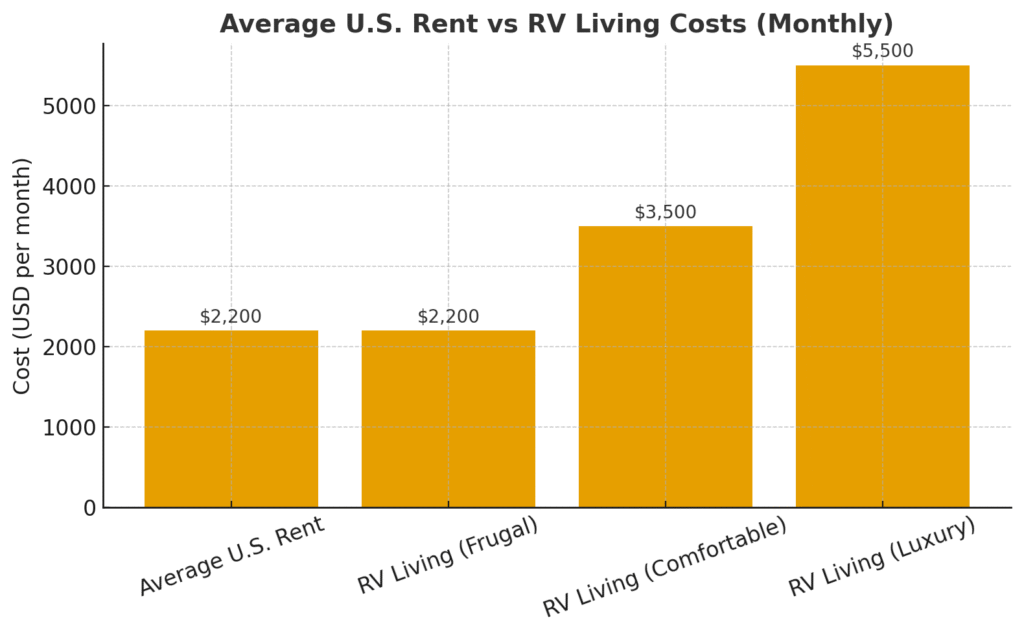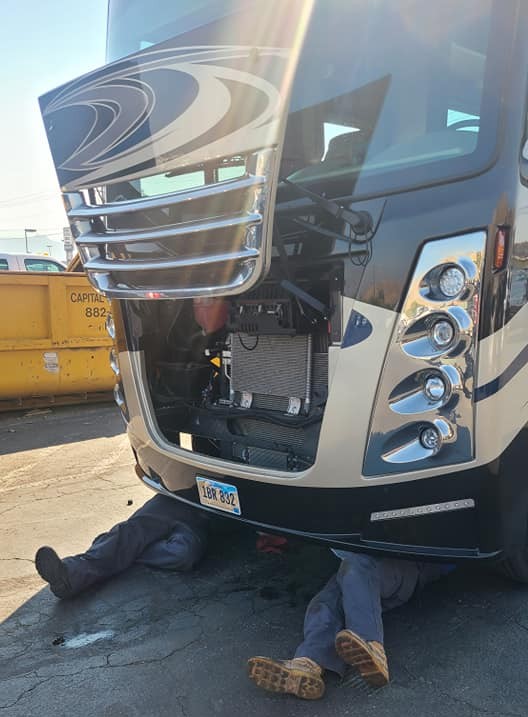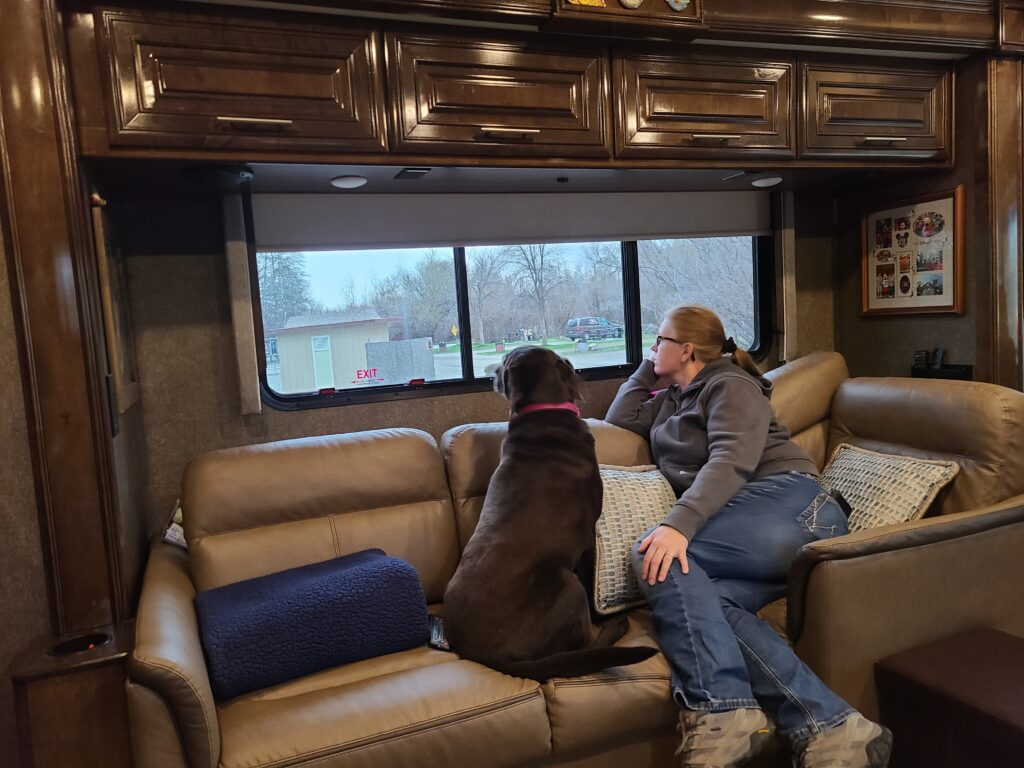When Lisa and I first started talking about going full-time in our RV, the very first question we had was simple: What’s the true cost to live in an RV full-time?
We got two totally different answers from people. Some said it was dirt cheap — “just boondock and it’s practically free.” Others swore it was outrageously expensive and only retirees with big pensions could afford it.
The reality? The cost to live in an RV full-time is flexible. We’ve met people who make it work on less than $2,000 a month, and others who easily spend $7,000+. It all comes down to your RV, your travel pace, and the lifestyle choices you make.
Lisa and I have been on the road for several years now, and here’s what we’ve learned about the real costs of RV life.

This post contains affiliate links. As a participant in Amazon Associates and various affiliate programs, we are compensated when qualifying purchases are made through our referral links at no additional cost to you. Full Disclosure
What’s the Real Cost to Live in an RV Full-Time?
Compared to traditional housing, RV life can absolutely save you money — but not always.
Think about it: the average U.S. mortgage or rent payment is well over $2,000 per month before you even add in utilities, property taxes, and maintenance.
With RV living, that “mortgage” might be your RV loan (if you have one), plus campground fees, insurance, and fuel. But utilities are flexible — you can boondock for free on BLM land or pay premium rates at an RV resort with pools and pickleball courts.

The cost of RV living isn’t one-size-fits-all. It can be frugal, mid-range, or luxury depending on how you travel.
Fixed Monthly Costs
These are the bills you’ll likely pay no matter how much you travel:
- RV Loan or Payment – If you financed your rig. Paid off? That’s a huge savings.
- Insurance – RV, tow vehicle (or toad), and health insurance. Shop around; rates vary wildly.
- Memberships – Programs like Thousand Trails, Harvest Hosts, KOA, and Passport America can pay for themselves quickly if you use them.
- Cell & Internet Plans – A must for most of us. Many RVers carry plans with AT&T, Verizon, or T-Mobile, plus hotspots or boosters.
- Storage – If you downsized but still keep belongings in storage, tack this onto your monthly budget.
Ready to Save on Campgrounds?
Looking to explore Thousand Trails without a big upfront investment? The Thousand Trails Camping Pass is a great way to get started—no long-term contract required. Camp “free” at hundreds of campgrounds for one flat annual fee!
👉 Get $155 Off Your Camping Pass
Variable Monthly Costs
This is where your actual RV living expenses fluctuate:
- Fuel – Moving fast burns money. Travel slowly, and fuel costs drop dramatically.
- Campground Fees – Range from free (boondocking) to $60+ a night at resorts. Military FamCamps are often a great deal if you’re eligible.
- Propane & Electricity – Heaters, stoves, and hot water all add up in colder months.
- Groceries & Dining – Similar to home, but we find ourselves eating out more often when exploring new places.
- Maintenance & Repairs – RVs shake, rattle, and break. Budget for oil changes, tires, and surprise fixes.
- Entertainment & Adventures – Tours, kayaking trips, fishing permits, National Park passes — they all add up.

Real-World Numbers: What We Spent
So what does the cost to live in an RV full-time look like in real life? When we tracked our first year, we learned quickly that some months are lean and others are splurge-worthy.
Here’s a ballpark idea:
- Frugal RVing: $1,800–$2,500/month
(Lots of boondocking, slower travel, cooking at home, minimal extras) - Comfortable RVing: $3,000–$4,500/month
(Mix of campgrounds and boondocking, steady travel, memberships, occasional dining, and attractions) - Luxury RVing: $5,000+/month
(Premium parks, faster travel, frequent dining, big upgrades, guided tours)
👉 If you want to see our actual numbers, check out our posts:
- Full-Time RVing Expenses – Our First Year.
- Full-Time RVing Expenses – Our Second Year.
- Full-Time RVing Expenses – Our Third Year

Tips to Save Money on the Road
- Travel Slower – Fewer miles = lower fuel costs.
- Use Memberships Wisely – Thousand Trails, Harvest Hosts, and Boondockers Welcome can save hundreds.
- Cook More Often – We love sharing recipes that are perfect for the RV kitchen, like Slow Cooker Jambalaya.
- DIY Basic Repairs – A simple toolkit and YouTube can save you big bucks.
- Fuel Apps & Campground Discounts – Programs like GasBuddy, TSD Fuel, and RV Life Trip Wizard help cut costs.
Hidden Costs People Forget
Even the best-planned budgets can miss a few sneaky expenses:
- Depreciation – RVs lose value faster than houses.
- Upgrades & Gear – Solar panels, lithium batteries, new mattresses, induction cooktops… ask me how I know.
- Medical & Dental – We’ve even crossed into Mexico for dental care (read our Los Algodones dental experience).
- Pet Care – Vet visits, emergency care, and boarding add up. Our dog Sierra has special needs now, so this is a line item for us.

FAQ: Full-Time RV Living Costs
Is living in an RV cheaper than owning a house?
Yes, it can be. While traditional housing comes with fixed costs like mortgage, utilities, and property taxes, RV living is more flexible. Many full-time RVers spend between $2,000–$4,500 a month, depending on travel pace and camping style. Slow travel and boondocking often make RV life cheaper than owning a house.
How much does it cost to RV full time per month?
On average, expect anywhere from $2,000 to $6,000+ per month. A frugal RVer who boondocks often and travels slowly can stay closer to $2,000–$2,500, while a couple staying in resorts and traveling frequently may spend $5,000 or more.
What are hidden costs of full-time RVing?
Some overlooked expenses include RV depreciation, medical and dental care on the road, pet care, storage fees, and gear upgrades (solar, lithium batteries, new mattresses, etc.). These can sneak up on you if you don’t budget for them.
Can you live in an RV full time on a budget?
Absolutely. Many RVers live comfortably on a tight budget by boondocking, cooking meals at home, using campground memberships, and traveling slower to save fuel. It’s all about making lifestyle choices that fit your finances.
How much does it cost to maintain an RV?
Maintenance costs vary depending on your rig and how often you travel. On average, plan for $1,000–$3,000 a year for routine upkeep (oil changes, tires, brakes, generator service). Unexpected breakdowns can cost much more, so keeping an emergency fund is important.

Final Thoughts: The True Cost to Live in an RV Full-Time
So, what’s the bottom line? The cost to live in an RV full-time can be anywhere from $2,000 a month to over $6,000 — depending entirely on how you choose to travel.
That’s the beauty of RV life: flexibility. You can live frugally when you need to, splurge when you want to, and always adjust to your budget and lifestyle.
For us, the freedom, adventure, and experiences outweigh the unpredictability.
What about you? Would your ideal RV budget lean frugal, comfortable, or splurge? Share in the comments — I’d love to hear how you’d design your RV life.
If you’re looking to build your own home-based business like we have with this webpage, check out Wealthy Affiliate.
Wealthy Affiliate is an all-in-one platform that you can build your whole affiliate marketing business on. It combines training, software, and website hosting into one. This makes the whole process of starting an online business from scratch much easier, especially if you’re new to building a website.





